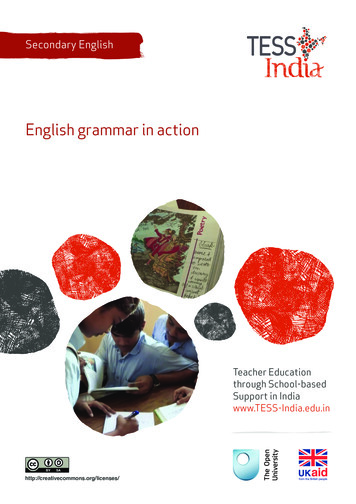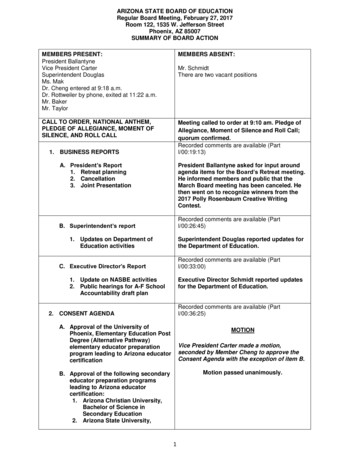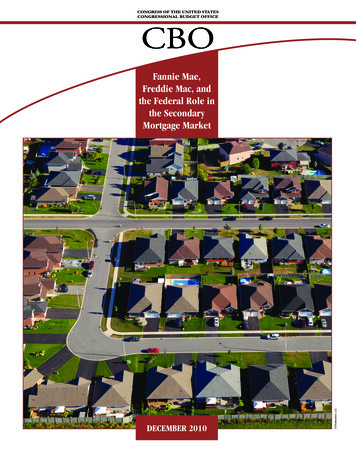
Transcription
Secondary EnglishEnglish grammar in actionTeacher Educationthrough School-basedSupport in rg/licenses/
TESS-India (Teacher Education through School-based Support) aims to improve the classroom practices ofelementary and secondary teachers in India through the provision of Open Educational Resources (OERs) tosupport teachers in developing student-centred, participatory approaches. The TESS-India OERs provideteachers with a companion to the school textbook. They offer activities for teachers to try out in theirclassrooms with their students, together with case studies showing how other teachers have taught thetopic and linked resources to support teachers in developing their lesson plans and subject knowledge.TESS-India OERs have been collaboratively written by Indian and international authors to address Indiancurriculum and contexts and are available for online and print use (http://www.tess-india.edu.in/). The OERsare available in several versions, appropriate for each participating Indian state and users are invited toadapt and localise the OERs further to meet local needs and contexts.TESS-India is led by The Open University UK and funded by the UK government.Video resourcesSome of the activities in this unit are accompanied by the following icon:. This indicates that youwill find it helpful to view the TESS-India video resources for the specified pedagogic theme.The TESS-India video resources illustrate key pedagogic techniques in a range of classroom contexts inIndia. We hope they will inspire you to experiment with similar practices. They are intended to complementand enhance your experience of working through the text-based units, but are not integral to them shouldyou be unable to access them.TESS-India video resources may be viewed online or downloaded from the TESS-India website,http://www.tess-india.edu.in/). Alternatively, you may have access to these videos on a CD or memory card.Version 2.0KarnatakaSE10v2Except for third party materials and otherwise stated, this content is made available under a CreativeCommons Attribution-ShareAlike licence: -India is led by The Open University UK and funded by UK aid from the UK government
English grammar in actionWhat this unit is aboutMy students spend a lot of time memorising grammar rules,and most of them can recite the rules. But many of them stillcan’t do grammar exercises correctly, and they don’t usecorrect grammar when they speak or write. What can I do tohelp my students learn and use English grammar correctly?Your students may be able to recite grammar rules, but this does not necessarily mean that they are able tocomplete grammar exercises in the textbooks or exams. Being aware of grammar rules does not alwaysmean that students can use language effectively when they speak or write. Memorising rules can be helpfulwhen learning a language, but there are other techniques that you can use to help your students tounderstand English grammar and use it more effectively in their writing and speaking.These techniques include: giving students activities that help them to notice how grammar is used in passages in theirtextbooks or in other textshelping students to guess grammar rules by looking at examples.The purpose of these techniques is for students to do activities that allow them to notice patterns ofEnglish grammar and practise grammar through writing and speaking. Doing this will enhance your students’ability to communicate in English (Lee and VanPatten, 2003).What you can learn in this unit How to help students use grammar to communicate.How to use the textbook and other resources to teach English grammar.How to help students notice patterns in English language use and guess grammar rules.Why this approach is importantGrammar is an integral part of a language. If you can help your students to improve their knowledge and useof English grammar, whatever their level, you will not only help them with their school studies and exams,you will help them to understand written and spoken English better. In real life, students do not usuallycarry a grammar book around to help them communicate their thoughts and feelings. Teaching grammar,therefore, includes preparing students to use grammar effectively in their daily lives.www.TESS-India.edu.in1
English grammar in action1 Different approaches to teaching grammarIn one class the teacher taught us reported speech. Theteacher wrote the rules on the board and told us to copy themin our notebooks. We had to learn the rules for homework. Inthe next class, the teacher asked me to stand up and say therules. I couldn’t remember them, and I felt embarrassed. I’dtried to learn them but they just didn’t stick in my head. Afterthat, we had a test with some grammar exercises on reportedspeech. I couldn’t remember the rules and I got a low grade. Myfriend remembered the rules but she didn’t get a very goodgrade either – she said that the rules didn’t make sense whenshe was doing the exercises.Pause for thoughtIf you can, discuss the following questions with a colleague. Do you have students in your classes who find it difficult to remember the grammarrules?Do you have students who remember the rules but still achieve only low grades?Some students will not spend time or effort learning the grammar rules, but other students will be like thestudent above: they will try to learn the rules but will find it difficult to remember them Even if they canremember them, they still need time to think of and apply the rules.A language cannot be learned through rules alone. Language learners need to use the language to becomefluent, and not just learn about it. They need to see and hear lots of examples of language being used, inorder to understand how it is used.Now read about the experiences of a Class X student.I get good grades in English grammar – in my last test I got 93 percent. But I still find it difficult to speak in English. A visitor cameto our school from abroad and asked us some questions in English.I couldn’t understand her very well. The teacher translated whatshe said, but I couldn’t answer the questions in English. I justcouldn’t think of the language quickly enough.Pause for thoughtIf you can, discuss these questions with a colleague: 2Do you have students like this in your classes?Why do you think they have problems speaking in English, even though they may getgood grades for grammar?www.TESS-India.edu.in
English grammar in actionSome students may be able to do written grammar exercises very well, but that does not always mean thatthey are able to use it well when they are writing or speaking English. To use grammar effectively, studentsneed to be able to practise it in different kinds of speaking and writing situations – not just grammarexercises or tests.Activity 1: Approaches to teaching English grammarThere is no ‘right’ way to teach English grammar. However, if you vary your approach to teaching grammar,you will help more students to understand and use it, both in exams and in real-life situations. Usingexamples and having students guess grammar rules can help them learn and use the rules successfully.Seeing how the language works in context can have more impact than just memorising a grammar rule.Here are three different ways to teach a grammar point. The examples here are about reported speech,which is commonly taught in secondary English textbooks, but you could use any grammar point: This approach focuses mostly on the grammar rule. Mrs Aparajeeta writes the grammar point onthe board (‘Reported Speech’) and gives them the following rule:‘If the verb in the original sentence is in the present tense in direct speech, it shifts topast tense in reported speech.’ After that, she tells students to do the exercises on reported speech in the textbook individually.She then asks them to memorise the rule for homework.This approach is more interactive, as the teachers asks students to come up with examples. MrKapur writes the grammar point on the board (‘Reported Speech’) and explains the rule (as above).As he explains, he writes some examples of changing direct speech to indirect speech on the board,as shown in Table 1.Table 1 Examples of direct and reported speech.ExampleTense IntroductionDirect speechReported speechKemal said:‘I want a samosa.’Kemal said that hewanted a samosa.Simple pastSimple presentSimple pastThen he organises students into groups and asks them to write some sentences in direct speech.He asks groups to exchange their sentences and change them from direct speech to indirectspeech.In this approach, the teacher gets the students to try to guess what the rule is from examples. MrsAgarwal writes a sentence using reported speech on the board:‘Sachin Tendulkar said he had never tried to compare himself to anyone else.’She writes Sachin’s original sentence on the board:‘I have never tried to compare myself to anyone else.’www.TESS-India.edu.in3
English grammar in actionShe then asks students to tell her the differences between the sentences. She does this with a fewmore examples, and asks students if they can say what the rules of reported speech are. Once thestudents say their ideas, the teacher explains the rules, and asks her students to practise withsome other sentences.Over the next few lessons, try each of these approaches with your classes. After each lesson, think aboutwhat your students learnt with each approach: which students have learnt the grammar point and whichstudents need more help to become confident with the grammar point? How will you help these students?Can they help each other?Then compare your experiences with Resource 1, which gives the benefits and challenges of eachapproach listed above.Case Study 1: Mr Talwar’s different approach to teaching EnglishgrammarMr Talwar teaches English to Class IX in a government school. He explained reported speech to hisstudents, and wrote the rules and some examples on the board. Most of his students could recite the rulesand examples, but then they did not get very good grades in their exam.I wondered how I could help my students understand reported speech better. I could see that memorisingthe rules wasn’t helping them to understand the grammar point, and it wasn’t helping them to use it. Theyneeded to see more examples of the structure, and they needed more practice in using reported speech. Iwrote examples of some direct speech on the board, including a variety of tenses. To make it moreinteresting and more relevant to the students’ lives, I made up some sentences about a famous person andwrote these on the board in direct speech. ‘I live in Mumbai with my wife and children.’‘My mother always believed I would be an actor.’‘I’ve just won an award.’‘I’m going to star in a new film next month.’On the other side of the board, I wrote ‘Shah Rukh Khan said:’.I asked the class, ‘What would these sentences be in reported speech?’ I didn’t think that they would know,but one student raised her hand and she gave me the answer for the first sentence:He said that he lived in Mumbaiwith his wife and children.I praised her, and wrote the sentence on the board. I asked her: ‘How did you know the correct answer?’ Shesaid she wasn’t sure. I asked about the other sentences, and sometimes students knew how to put them inreported speech and sometimes they didn’t. As we did the activity, I explained the rules of how to formindirect speech.Once I explained the rules and students had seen several examples, I thought that students would needmore practice. After all, only a few students had participated so far. So I organised my students into pairs,and told them to write down some sentences in direct speech. I told them that they should imagine that thesentences were spoken by a famous person. I asked for some examples from the room:4www.TESS-India.edu.in
English grammar in actionI was born in Delhi.I have three children.I gave the class five minutes to write some sentences in direct speech. As they wrote, I walked around theroom and checked some of the pairs. I kept checking to make sure that all of the students were busywriting! After five minutes, I told the students to stop and to exchange their sentences with the pair nextto them. Once each pair had another pair’s sentences, I asked them to turn the sentences – the directspeech – into indirect speech. Again, I gave the class a time limit of ten minutes to change the sentencesinto indirect speech.It would be good to be able to spend more time doing these activities, but I already have so much to fit intothe classes – I couldn’t spend too much time on this. Anyway, giving a time limit makes sure that thestudents stay focused.As the class worked, I walked around again and tried to check as many sentences as I could. I could see thatsome of the students were having problems, so I showed those pairs how to make the sentences. Ofcourse, it was impossible to check and help every pair, but at least they all had a chance to think about thegrammar point. And I’ve realised that students need to have some time to think and try to use grammarstructures. When the ten minutes were up, I asked some students to give some examples, which gave me achance to see if they understood, and it gave the class an opportunity to discuss the rules again.2 Using the textbook to practise English grammarGrammar is not an isolated part of language. You can use the lessons in your textbook to help studentsunderstand how English is structured and to teach how the language is actually used.Pause for thoughtRead this extract of a lesson from NCERT Class X textbook, First Flight. As you read it, thinkabout the following questions: What kinds of grammatical structures are regularly used in the passage?How could you use this passage to help students with English grammar?Early in the New Year of 1956 I travelled to Southern Iraq. By then it hadcrossed my mind that I should like to keep an otter instead of a dog, and thatCamusfeàrna, ringed by water a stone’s throw from its door, would be aneminently suitable spot for this experiment.When I casually mentioned this to a friend, he casually replied that I had betterget one in the Tigris marshes, for there they were as common as mosquitoes,and were often tamed by the Arabs. We were going to Basra to the ConsulateGeneral to collect and answer our mail from Europe. At the Consulate-Generalwe found that my friend’s mail had arrived but that mine had not.I cabled to England, and when, three days later, nothing had happened, I tried totelephone. The call had to be booked twenty-four hours in advance. On the firstday the line was out of order; on the second the exchange was closed for awww.TESS-India.edu.in5
English grammar in actionreligious holiday. On the third day there was another breakdown. My friend left,and I arranged to meet him in a week’s time. Five days later, my mail arrived. Icarried it to my bedroom to read, and there, squatting on the floor, were twoArabs; beside them lay a sack that squirmed from time to time. They handedme a note from my friend: ‘Here is your otter ’This extract has examples of several grammar points. Here are some, but you may have others to add to thelist: past tenses (‘travelled’, ‘had crossed my mind’)reported speech (‘he casually replied that I had better’)passive voice (‘were often tamed’).Passages such as these provide examples of how grammar is used, and you can point these out to yourstudents. You can also ask your students to read the extract and look for – or underline – examples of acertain grammar task. For example, they could underline all the examples of the past simple tense. This is agood way to help students review grammar points that they have already learned, or should know at this level.Case Study 2: Mr Banerjee reviews present tensesMr Banerjee was recently transferred to a government school in a rural district. He had previously taughtin the capital city.When I began teaching the students of Class IX, I was shocked to see how quiet students were during theirlessons: they did not laugh at my jokes, or respond to my questions, or enjoy writing on the board. Theyseemed to be afraid that I would punish them for making grammatical mistakes in their speaking andwriting. I realised that I would have to make my students relax in the class and develop the confidence tospeak and write in English.I looked for an appropriate lesson in the English textbook to illustrate this. Unit 3, of their English textbook(CBSE’s Interact in English), called ‘Environment’, had a description of the Indian rhinoceros [see Resource 2].I felt this would be a good way of showing how the present simple tense is used to describe people or things.Before I began, I divided the class into groups of five and asked them the following:Students, can you please work together to write fivesentences describing this classroom. One person is the scribefor the group. The rest of you tell them what to write.Two groups managed to write accurate descriptions in simple English, but most others wrote descriptions thatwere not grammatically correct. Some wrote sentences without the verb. Others used a mixture of tenses.I then asked students to put their texts aside and told them we would come back to them.I told students to open their book at Unit 3 and to read the passage on the Indian rhinoceros. While theywere reading, I wrote sentences with verbs in the present simple tense and asked students to completethem with information from the passage:6www.TESS-India.edu.in
English grammar in actionAfter they completed the sentences, I drew their attention to the parts of the text that described thefeatures of the rhino, and then to the verbs used in these sentences. I pointed out how the present simpletense is used to describe something that is true generally.I then reminded them of subject/verb agreement rules for the present simple (‘It lives’ and ‘They live’; ‘Ithas’ and ‘Rhinos have’). At that point I felt that students had noticed how present simple is used inpassages, and I had reminded them of the rules of forming it. I then wanted to see whether they couldcorrect their own writing.So I asked my students to look back at their own descriptions of the classroom and to see if they couldmake them better. I was pleased that the students were eager to edit and then read out their passages tothe class. This time, the students structured their sentences far more accurately.Activity 2: Using the textbook readings to teach grammarThis is an activity for you to do with your students.In Case Study 2, the teacher used the textbook to help students notice how the present tense is used andto use it more accurately in their writing. The textbook is a useful resource for teaching and reviewingEnglish grammar, especially if you don’t have a specific grammar book. Follow the steps below to use thistechnique in your classroom: Identify an area of grammar that you feel your students are having problems with (for example,using past tenses).Choose a lesson that has some examples of this grammar point.Organise students into pairs and ask them to find – or underline – examples of the grammar pointin the lesson reading. Before they begin, do an example with the whole class so that everyoneunderstands what they need to do. Set a time limit, e.g. three minutes.After several minutes, ask students to give you the examples, and write them on the blackboard.Try to ask students from different parts of the classroom to make sure everyone feels involved.For each example, ask students to explain why that grammar point is used. If students can’t explain,help them by asking more questions. Try not to give the explanation yourself.Ask questions about the form or spelling.www.TESS-India.edu.in7
English grammar in action To find out how much your students have understood, give them an error-correction exercise. Takea few more sentences from the lesson and copy them out onto the board, inserting a few mistakes.Ask students to copy down the sentences and correct the mistakes in pairs. Give them a time limit for thisand then review the corrections with the class.Pause for thoughtHere are some questions for you to think about after trying this activity. If possible, discussthese questions with a colleague. Were your students able to identify the examples in the lesson from the textbook? Ifnot, how could you help them?What did this exercise tell you about your students’ skills? Which students found itdifficult to correct the mistakes? How can you help them to correct their ownmistakes?You could help your students find examples by discussing the grammar point before they look, and givingthem some examples. You could give them clues such as: ‘There is an example in the third paragraph.’ Forexamples of the language you could use in this kind of activity, see Resource 3.If your students can’t identify their own mistakes, you could mark them so that students know where themistakes are. Don’t tell them what the mistake is – just tell them what sentence it is in. Or you can askquestions about the mistake: for example, ‘The person here is “my mother”, so what form of the verb “have”do you need?’When doing this kind of activity, make a note of which students seem to grasp the language easily, as wellas ones who find it difficult. Some students may be ready to learn more, while others need more practice. Ifyou notice that many of the students in your class need more practice, then you can do a grammar activitylike this every day. If only one or two students seem to be struggling, you can work with them individually orassign them special homework so that they can improve over time.3 Using other resources to practise English grammarYou can find examples of grammar structures that students need to learn in English textbooks. You can alsofind them in texts that you encounter in your daily life, such as newspapers, magazines, advertisements – evenwedding invitations. There are many advantages of using real texts to illustrate a grammar point. They: help students understand that grammar is more than a set of rules to memoriseprepare them to use such structures themselves in speech and writingencourage them to see grammar and English as being a relevant subject in their lives.(See the unit Local resources for teaching English for further examples of everyday texts that you could usein your English classes, as well as Resource 4, ‘Using local resources’.)Video: Using local resources8www.TESS-India.edu.in
English grammar in actionCase Study 3: Mrs Chakrakodi uses a food wrapper to review theimperativeMrs Chakrakodi teaches English in a secondary school. Many of her students have problems with grammarstructures that she thinks they should know by now. For instance, her students had problems using theimperative in a textbook exercise. She decided to try something which would help them to remember anduse it.I noticed that Maggi noodles carry quick and simple recipes that even teenagers can try at home. I decidedto use recipes to teach my students the imperative.One day I asked my Class IX students to bring empty Masala Maggi wrappers to the class. Before talkingabout making Maggi, I started a conversation about what they could cook, and whether they knew how tomake tea. We had a whole-class discussion and I elicited from them the steps to make tea, which I put onthe board. There were sentences like ‘We boil water’, ‘I put in sugar’, ‘I put in milk’, ‘I add one spoon of milkpower’, etc.Amid a lot of laughter, we argued about whether to put sugar in the cup first, or tea leaves in the wateritself, and I finally wrote the steps on the board, making a point to use imperative sentences (‘Pour a cup ofwater in a kettle and boil ’, ‘Add a spoonful of sugar ’). Without my students necessarily realising it, Iwas reviewing the use of the imperative and its structure. I pointed out that the first word of eachsentence was a verb, and that these sentences give instructions.With the students ready to use the structure, I divided them into groups and asked them to look at therecipes on the Maggi wrappers that they had brought from home. Their task was to discuss all the recipes,and to make a new and more interesting one using tips from all of them, using the imperative.Figure 1 Students discuss the recipes on Maggi wrappers.As the students worked I walked around the groups, helping where necessary. After fifteen minutes, Istarted taking feedback. I asked a student from one of the groups to read out their recipe, which I wrotedown on the board. We then discussed the recipe together, trying to add or change details wherenecessary. We also corrected any mistakes with the imperative.www.TESS-India.edu.in9
English grammar in actionActivity 3: Using other resources to practise English grammarThis is an activity for you to do with your students.Here are some everyday objects and texts from real life that have English text. Consider how you could usethem to teach grammar: An empty food wrapper (Figure 2).Figure 2 A Maggi food wrapper. Newspaper headlines:o ‘World Cup: defending champions Spain defeated 5–0 by the Netherlands’o ‘Man caught with 6 gold bars in Goa airport’Wedding invitations (Figure 3).Figure 3 Two wedding invitations.10www.TESS-India.edu.in
English grammar in actionThere are many ways that you could use these objects to teach grammar. Here are some suggestions,although you may have more ideas that you could share with your colleagues: Food packets sometimes have recipes on them. You could use these recipes to teach or review thelanguage of instructions, for example the imperative (‘Heat some oil ’). Students could writerecipes using the imperative. The packets could lead to a discussion of how Maggi noodles aremade, or about students' opinions on the best way to cook Maggi noodles (with cheese, egg, tuna,etc. )The headlines use the passive voice. The full sentences would be ‘The defending champions Spainwere defeated 5–0 by the Netherlands’ and ‘A man has been/was caught with six gold bars in Goaairport’. Students could write headlines about local events using the passive voice, or transferthem into the active voice.The invitations in Figure 3 highlight the passive and active voice. You could also use them to reviewadverbs (‘cordially’) or prepositions (‘on Sunday’; ‘at Hotel Park Continental’).What objects can you collect to teach and review English grammar to your classes? You could even takephotos of any examples of English that you see used around you. See Resource 5, ‘Planning lessons’, formore on this.Plan a lesson to teach and review a grammar point using one of these ideas and resources from foodpackets, adverts, newspapers or magazines.Video: Planning lessonsPause for thoughtHere are some questions for you to think about after trying this activity. If possible, discussthese questions with a colleague. Do you think that this activity helped your students to remember the grammar point,and to use it more accurately?If so, why? If not, why not?Using resources besides the textbook can make a change for students. Using a resource like the Magginoodles package can help students notice how English is used around them and how they might use thelanguage for their own purposes.4 SummaryIn this unit you explored teaching techniques that help your students to move away from memorisinggrammar rules to noticing how grammar is used in order to use language correctly in their speech andwriting. These techniques include giving your students activities that help them to notice how grammar isused in passages in their textbooks or in other texts, and helping students to guess grammar rules bylooking at examples. These techniques will help you support your students in learning to use English forcommunicative purposes and can be used regularly with your students.www.TESS-India.edu.in11
English grammar in actionIf you would like to practise and improve your own grammar, see Resource 3. If you would like to read more aboutintegrating grammar into your lessons and students discovering the rules, look at the additional resources.ResourcesResource 1: Other approaches to teaching English grammarTable R1.1 Other approaches to teaching English grammar.TeacherBenefitsProblemsAIt’s quick. Students practise with anexerciseMemorising rules has some problems: somestudents can’t remember; and it can be difficult toapply the rulesCan be effective with lower levelsStudents don’t get a lot of practice (one exercise);what about the students who don’t understand?BStudents see more examples of thegrammar point, and get more practicethan the approach of Teacher AIn groups, students can help each other(especially if someone didn’t understandthe explanation)When students write their ownsentences, they remember them moreCStudents see several examples; theywork the rules out for themselves – thishelps them to remember moreIt takes longer than the approach of Teacher AStudents might write incorrect sentencesSome students in a group might do all of the work,and others may not workThe sentences are all different so the teacher can’tcheck all of the workCan be difficult for students who are not used to it;takes more time than the approaches of TeachersA and BResource 2: Extract from a textbookThis prehistoric-looking rhinoceros has thick, silver-brown skin which becomes pinkish near the large skinfolds that cover its body. The male develops thick neckfolds. It has very little body hair aside fromeyelashes, ear-fringes and tail-brush. These rhinos live in tall grasslands and riverine forests, but due tohabitat loss they have been forced into more cultivated land. They are mostly solitary creatures, with theexception of mothers and calves and breeding pairs, although they sometimes congregate at bathing areas.The Indian rhinoceros makes a wide vari
English grammar and practise grammar through writing and speaking. Doing this will enhance your students' ability to communicate in English (Lee and VanPatten, 2003). What you can learn in this unit How to help students use grammar to communicate. How to use the textbook and other resources to teach English grammar.










